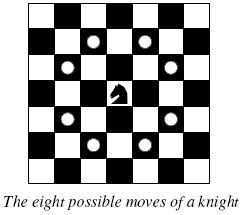POJ2488-A Knight's Journey(DFS+回溯)
题目链接:http://poj.org/problem?id=2488
A Knight's Journey
| Time Limit: 1000MS | Memory Limit: 65536K | |
| Total Submissions: 36695 | Accepted: 12462 |
Description
 Background
Background The knight is getting bored of seeing the same black and white squares again and again and has decided to make a journey
around the world. Whenever a knight moves, it is two squares in one direction and one square perpendicular to this. The world of a knight is the chessboard he is living on. Our knight lives on a chessboard that has a smaller area than a regular 8 * 8 board, but it is still rectangular. Can you help this adventurous knight to make travel plans?
Problem
Find a path such that the knight visits every square once. The knight can start and end on any square of the board.
Input
The input begins with a positive integer n in the first line. The following lines contain n test cases. Each test case consists of a single line with two positive integers p and q, such that 1 <= p * q <= 26. This represents a p * q chessboard, where p describes how many different square numbers 1, . . . , p exist, q describes how many different square letters exist. These are the first q letters of the Latin alphabet: A, . . .
Output
The output for every scenario begins with a line containing "Scenario #i:", where i is the number of the scenario starting at 1. Then print a single line containing the lexicographically first path that visits all squares of the chessboard with knight moves followed by an empty line. The path should be given on a single line by concatenating the names of the visited squares. Each square name consists of a capital letter followed by a number.
If no such path exist, you should output impossible on a single line.
If no such path exist, you should output impossible on a single line.
Sample Input
3 1 1 2 3 4 3
Sample Output
Scenario #1: A1 Scenario #2: impossible Scenario #3: A1B3C1A2B4C2A3B1C3A4B2C4
题目大意: 任选一个起点,按照国际象棋马的跳法,不重复的跳完整个棋盘,如果有多种路线则选择字典序最小的路线(路线是点的横纵坐标的集合,注意棋盘的横坐标的用大写字母,纵坐标是数字)
题目分析:
1. 应该看到这个题就可以想到用DFS,当首先要明白这个题的意思是能否只走一遍(不回头不重复)将整个地图走完,而普通的深度优先搜索是一直走,走不通之后沿路返回到某处继续深搜。所以这个题要用到的回溯思想,如果不重复走一遍就走完了,做一个标记,算法停止;否则在某种DFS下走到某一步时按马跳的规则无路可走而棋盘还有为走到的点,这样我们就需要撤消这一步,进而尝试其他的路线(当然其他的路线也可能导致撤销),而所谓撤销这一步就是在递归深搜返回时重置该点,以便在当前路线走一遍行不通换另一种路线时,该点的状态是未访问过的,而不是像普通的DFS当作已经访问了。
2. 如果有多种方式可以不重复走一遍的走完,需要输出按字典序最小的路径,而注意到国际象棋的棋盘是列为字母,行为数字,如果能够不回头走一遍的走完,一定会经过A1点,所以我们应该从A1开始搜索,以确保之后得到的路径字典序是最小的(也就是说如果路径不以A1开始,该路径一定不是字典序最小路径),而且我们应该确保优先选择的方向是字典序最小的方向,这样我们最先得到的路径就是字典序最小的。
参考代码:
#include <cstdio> #include <cstring> using namespace std; const int MAX_N = 27; //字典序最小的行走方向 const int dx[8] = {-1, 1, -2, 2, -2, 2, -1, 1}; const int dy[8] = {-2, -2, -1, -1, 1, 1, 2, 2}; bool visited[MAX_N][MAX_N]; struct Step{ char x, y; } path[MAX_N]; bool success; //是否成功遍历的标记 int cases, p, q; void DFS(int x, int y, int num); int main() { scanf("%d", &cases); for (int c = 1; c <= cases; c++) { success = false; scanf("%d%d", &p, &q); memset(visited, false, sizeof(visited)); visited[1][1] = true; //起点 DFS(1, 1, 1); printf("Scenario #%d:\n", c); if (success) { for (int i = 1; i <= p * q; i++) printf("%c%c", path[i].y, path[i].x); printf("\n"); } else printf("impossible\n"); if (c != cases) printf("\n"); //注意该题的换行 } return 0; } void DFS(int x, int y, int num) { path[num].y = y + 'A' - 1; //int 转为 char path[num].x = x + '0'; if (num == p * q) { success = true; return; } for (int i = 0; i < 8; i++) { int nx = x + dx[i]; int ny = y + dy[i]; if (0 < nx && nx <= p && 0 < ny && ny <= q && !visited[nx][ny] && !success) { visited[nx][ny] = true; DFS(nx, ny, num+1); visited[nx][ny] = false; //撤销该步 } } }


